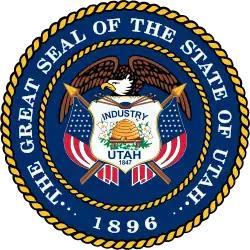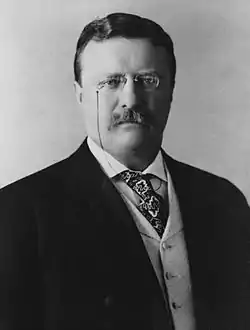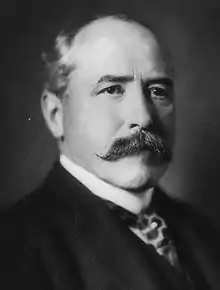1904 United States presidential election in Utah
The 1904 United States presidential election in Utah was held on November 8, 1904, throughout all forty-five contemporary states as part of the 1904 United States presidential election. State voters chose three representatives, or electors to the Electoral College, who voted for president and vice president.
| |||||||||||||||||||||||||||||||||
| |||||||||||||||||||||||||||||||||
 County Results
| |||||||||||||||||||||||||||||||||
| |||||||||||||||||||||||||||||||||
| Elections in Utah |
|---|
 |
Background
In its first presidential election during its statehood year, Utah – with its large reserves of silver – had voted five-to-one for Democrat/Populist William Jennings Bryan, who ran on a platform of monetizing silver. However, with a revived economy, Utah moved much closer to the national mainstream in the ensuring 1900 election, as pre-statehood Republican Party hostility to the dominant LDS church gradually disappeared after the outlawing of polygyny in 1890.[1]
In between Utah’s second and third presidential elections, newly elected but unseated senator and Mormon apostle Reed Smoot went much further towards reversing the nineteenth-century hostility of the Republican Party to the Latter Day Saints. At a time when most traditional Protestant congressmen were opposed to Smoot being seated because religious influence was feared,[2] Mormon prophet and LDS Church President Joseph F. Smith said explicitly that members of the LDS Church should in political matters obey their consciences. Smoot – although a Republican – had been targeted by both major parties in the two years between his election by the Utah Legislature in 1902 and the 1904 presidential campaign, but he corresponded consistently with incumbent president Roosevelt.[3]
Smoot’s work was one factor allowing Roosevelt to sweep twenty-six of Utah’s twenty-seven contemporary counties and carry the state by 28.55 percentage points, which even in the largest landslide since the beginning of widespread popular voting for presidential electors made Utah 9.73 percentage points more Republican than the nation at-large. Another was that Parker himself was hostile to Mormon polygyny,[4] still another was the popularity in the West of Roosevelt’s conservation and trust-busting policies.[5]
Roosevelt’s percentage of the popular vote and margin would be bettered by no Republican in Utah until Dwight D. Eisenhower’s re-election in 1956.[6]
Results
| 1904 United States presidential election in Utah[7] | ||||||||
|---|---|---|---|---|---|---|---|---|
| Party | Candidate | Running mate | Popular vote | Electoral vote | ||||
| Count | % | Count | % | |||||
| Republican | Theodore Roosevelt of New York | Charles Warren Fairbanks of Indiana | 62,452 | 61.41% | 3 | 100.00% | ||
| Democratic | Alton Brooks Parker of New York | Henry Gassaway Davis of West Virginia | 33,413 | 32.86% | 0 | 0.00% | ||
| Socialist | Eugene Victor Debs of Indiana | Benjamin Hanford of New York | 5,767 | 5.67% | 0 | 0.00% | ||
| Write-ins[lower-alpha 2] | — | — | 57 | 0.06% | 0 | 0.00% | ||
| Total | 101,632 | 100.00% | 3 | 100.00% | ||||
Results by county
| County | Theodore Roosevelt Republican |
Alton Brooks Parker Democratic |
Eugene Victor Debs Socialist |
Margin | Total votes cast[8] | ||||
|---|---|---|---|---|---|---|---|---|---|
| # | % | # | % | # | % | # | % | ||
| Beaver | 869 | 58.17% | 593 | 39.69% | 32 | 2.14% | 276 | 18.48% | 1,494 |
| Box Elder | 2,400 | 66.76% | 1,151 | 32.02% | 44 | 1.22% | 1,249 | 34.74% | 3,595 |
| Cache | 4,008 | 56.89% | 2,948 | 41.85% | 89 | 1.26% | 1,060 | 15.04% | 7,045 |
| Carbon | 1,224 | 65.38% | 508 | 27.14% | 140 | 7.48% | 716 | 38.24% | 1,872 |
| Davis | 1,657 | 56.42% | 1,255 | 42.73% | 25 | 0.85% | 402 | 13.69% | 2,937 |
| Emery | 905 | 56.67% | 583 | 36.51% | 109 | 6.83% | 322 | 20.16% | 1,597 |
| Garfield | 679 | 70.14% | 252 | 26.03% | 37 | 3.82% | 427 | 44.11% | 968 |
| Grand | 262 | 57.21% | 165 | 36.03% | 31 | 6.77% | 97 | 21.18% | 458 |
| Iron | 741 | 58.72% | 442 | 35.02% | 79 | 6.26% | 299 | 23.70% | 1,262 |
| Juab | 1,493 | 48.32% | 1,206 | 39.03% | 391 | 12.65% | 287 | 9.29% | 3,090 |
| Kane | 399 | 79.64% | 102 | 20.36% | 0 | 0.00% | 297 | 59.28% | 501 |
| Millard | 1,001 | 59.23% | 683 | 40.41% | 6 | 0.36% | 318 | 18.82% | 1,690 |
| Morgan | 492 | 57.28% | 315 | 36.67% | 52 | 6.05% | 177 | 20.61% | 859 |
| Piute | 358 | 48.12% | 228 | 30.65% | 158 | 21.24% | 130 | 17.47% | 744 |
| Rich | 439 | 64.65% | 240 | 35.35% | 0 | 0.00% | 199 | 29.30% | 679 |
| Salt Lake | 20,665 | 65.10% | 8,389 | 26.43% | 2,691 | 8.48% | 12,276 | 38.67% | 31,745 |
| San Juan | 135 | 78.49% | 36 | 20.93% | 1 | 0.58% | 99 | 57.56% | 172 |
| Sanpete | 3,829 | 66.65% | 1,741 | 30.30% | 175 | 3.05% | 2,088 | 36.35% | 5,745 |
| Sevier | 1,725 | 59.10% | 930 | 31.86% | 264 | 9.04% | 795 | 27.24% | 2,919 |
| Summit | 2,232 | 57.87% | 1,358 | 35.21% | 267 | 6.92% | 874 | 22.66% | 3,857 |
| Tooele | 1,289 | 63.44% | 639 | 31.45% | 104 | 5.12% | 650 | 31.99% | 2,032 |
| Uintah | 753 | 50.40% | 630 | 42.17% | 111 | 7.43% | 123 | 8.23% | 1,494 |
| Utah | 6,490 | 59.15% | 4,243 | 38.67% | 239 | 2.18% | 2,247 | 20.48% | 10,972 |
| Wasatch | 1,042 | 60.79% | 656 | 38.27% | 16 | 0.93% | 386 | 22.52% | 1,714 |
| Washington | 718 | 48.38% | 761 | 51.28% | 5 | 0.34% | -43 | -2.90% | 1,484 |
| Wayne | 310 | 53.26% | 251 | 43.13% | 21 | 3.61% | 59 | 10.13% | 582 |
| Weber | 6,337 | 62.59% | 3,108 | 30.70% | 680 | 6.72% | 3,229 | 31.89% | 10,125 |
| Totals | 62,452 | 61.41% | 33,413 | 32.86% | 5,767 | 5.67% | 29,039 | 28.55% | 101,632 |
Notes
- Robinson‘s The Presidential Vote has a figure of 62,446 votes, but the county votes sum to 62,452
- These write-in votes not tabulated by counties but given as a state-wide totals.
References
- Balmer, Randall and Riess, Janet (editors); Mormonism and American Politics (Religion, Culture, and Public Life), pp. 135-137 ISBN 0231540892
- Perry, Luke and Cronin, Christopher; Mormons in American Politics: From Persecution to Power, p. 52 ISBN 1440804087
- Perry and Cronin; Mormons in American Politics, p. 54
- Murdock, Dr. Everett E.; From Washington and Adams to Hillary and Trump: The Stories behind the Story of Every U.S. Presidential Election, p. 120 ISBN 0923178317
- Menendez, Albert J.; The Geography of Presidential Elections in the United States, 1868-2004, p. 36 ISBN 0786422173
- Dave Leip’s U.S. Election Atlas; Presidential General Election Results Comparison – Utah
- "1904 Presidential General Election Results – Utah". U.S. Election Atlas. Retrieved 23 December 2013.
- Robinson, Edgar Eugene; The Presidential Vote; 1896-1932 (second edition); pp. 223-224 Published 1947 by Stanford University Press



